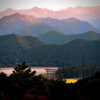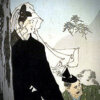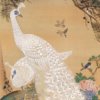Summary | Art History of Japan | Painting | No.5 Early Shōwa Period – The Pacific War
Early Shōwa Period – The Pacific War
Now, the next stage is the early Shōwa period.
We will look at the period between 1926 and the end of the Pacific War in 1945.
What movements took place in this period was a return to the classics.
Around the Taishō period, there was a movement to study the Rinpa school, starting with Tawaraya Sōtatsu, which was further accelerated by a trend to study older objects that had their own roots.
It’s what we’ve been looking at. For example, the early Kanō school, Sesshū Tōyō, and the Yamato-e paintings of the Heian period.
And the Japanese painters of the time thought the following.
‘Isn’t there something in the expression of these old works that identifies us? And by expressing it in the current Japanese painting, can we create a new form of expression?’
There has been a return to the classics in this way.
And as older works gained re-evaluation, the conflict between the new school and the old school that existed up to that time disappeared.
Why?
The ideology of the new school was to evolve old Japanese painting by adding new things to it, while the ideology of the old school was to preserve old Japanese painting and keep it as it was. However, the old Japanese painting that these two schools meant was the Japanese painting from the mid-Edo period onwards, and did not focus on the Japanese painting before that time.
However, both the new school and the old school began to explore and re-evaluate older Japanese paintings, which had not been their focus before, and incorporated them into their own styles, so there are no longer many points in distinguishing between the new and old schools.
Yes, and as time went on, the footsteps of war came closer and closer to Japan.
One of the most famous events that occurred during this period was the reform of the Teiten called the Matsuda Reorganisation.
Because of the problem of collusion with power, the Bunten exhibition was reborn as the Teiten exhibition, but after all, this problem was recurring again at the Teiten exhibition.
At that time, winning a prize at the Bunten or Teiten exhibition was a considerable status.
So the painters lobbied hard to win the prize at all costs, but the lobbying led to a flood of criticism towards the Teiten, arguing that the work chosen by the lobbying was not a work of art.










